Chelsea have faced substantial criticism over the past two seasons for purchasing numerous young talents at high prices — especially in their attack, which now consists of nine players who could comfortably start at other clubs in Europe’s top-five leagues.
This tactical analysis
explainshow Enzo Maresca has been integrating all his attackers into a playing style that has enabled them to score goals easily in the Premier League this season.
We’ll examine the key tactics that have been implemented, allowing them to break down opposing defenders in the Premier League.
This season alone, they’ve spent €238m on transfers, with an average player age of 22.9; the market value of these players totals €456m.
Speculation has frequently swirled around how Chelsea would fit all these players into a cohesive system and keep them content, especially after previous managers like Graham Potter and Mauricio Pochettino struggled to do so.
Now, it’s up to Enzo Maresca’s tactics to try and uplift Chelsea after a few rough seasons.
Responding to critics, Maresca himself stated, “I work with 21 players. The other 15-20 are training apart,” pushing back on questions about the size of his squad.
Chelsea has been doing well this season, sitting in seventh place with 14 points in eight games.
They have scored 17 goals—the third-most in the league—and won both games in the UECL.
Chelsea has been missing a robust and consistent attack for quite some time; the last time they had a formidable offence that competed on the European stage and dominated the Premier League was with Eden Hazard and Diego Costa.
Since then, attacks have come and gone with inconsistent results.
While they won the Champions League in 2021, much of the credit went to their monstrous defence and midfield.
This year, however, shows promise as the team starts to unite around their coach’s philosophy.
Enzo Maresca’s Style Of Play
Enzo Maresca’s style of play was heavily influenced by his time learning from Pep Guardiola’s tactics, which brings a progressive and flexible approach to Chelsea’s tactical setup.
Enzo Maresca’s coaching philosophy emphasises fluid, possession-based play with structured build-up from the back.
Maresca is known for utilising adaptable formations and pressing strategies that allow his players to transition smoothly between offensive and defensive phases.
At Chelsea, he aims to maximise player versatility, encouraging midfielders like Enzo Fernández and Moisés Caicedo to fit seamlessly into his system by adapting to different roles and responsibilities on the pitch.
A critical aspect of Maresca’s coaching style is his focus on controlling the game tempo and effectively exploiting spaces.
Enzo Maresca’s Tactics At Chelsea FC
Enzo Maresca’s Chelsea attack leverages central overloads and fluid positioning to create dynamic forward momentum.
By inverting full-backs like Malo Gusto and Marc Cucurella, Chelsea established control in the middle of the park, linking the defence and midfield through quick, short passes.
This structure frees up players like Enzo Fernández and Moisés Caicedo to push forward, supporting Cole Palmer, who acts as a versatile number 10.
Palmer’s ability to connect with wingers like Mykhailo Mudryk and Noni Madueke stretches defences wide, opening central channels.
With Nicolás Jackson’s movement to pull defenders, Chelsea’s setup enables rapid, high-tempo transitions from possession to attack, maximising space and offensive depth.
Chelsea FC Shot Map
As shown in the Chelsea shot map below, Chelsea are overperforming their xG of 25.64 with 28 non-penalty goals, indicating an improvement in their finishing.
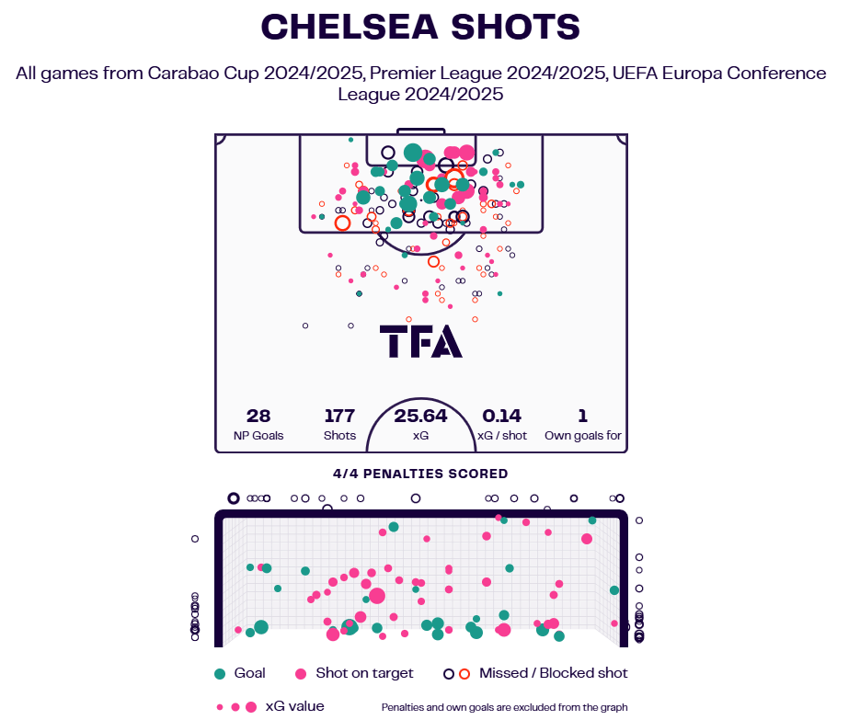
Chelsea FC Penetrating Carries Map
The focus here isn’t the quantity of penetrating carries but where these carries originate.
Observing the edges of the penalty box, you’ll notice they favour the corners, opting for penetrating runs from wide areas rather than centrally.
Their wingers execute daring plays to enter the 18-yard box through these zones.
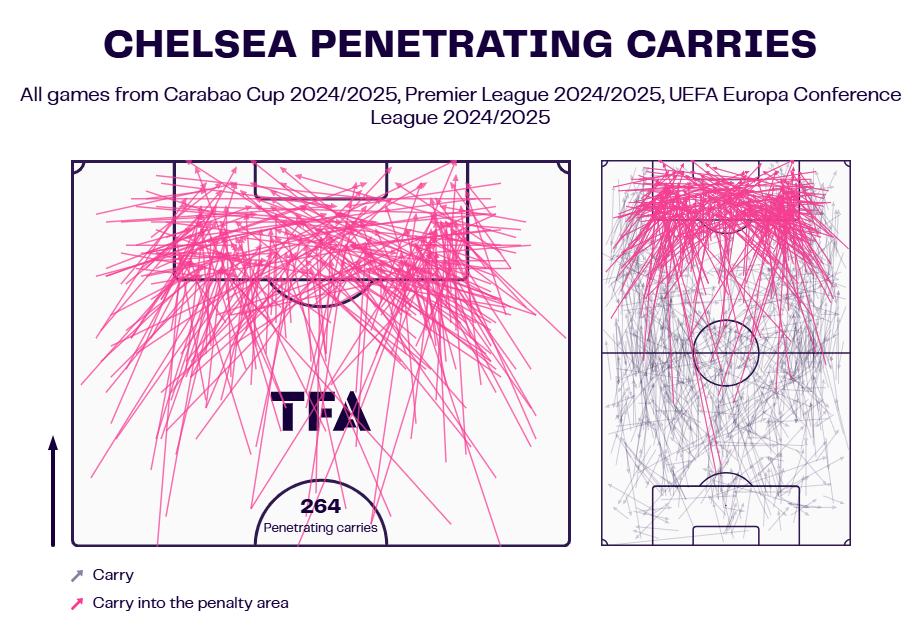
Chelsea FC Ball Progression Map
Similarly, Chelsea’s wide approach is evident in their ball progression map.
They look to enter the penalty area from the wide zones and corners, where their wingers thrive with space and one-on-one opportunities.
This wide progression aligns with their overall offensive strategy, focusing on exploiting the flanks and creating attacking threats from the sides.
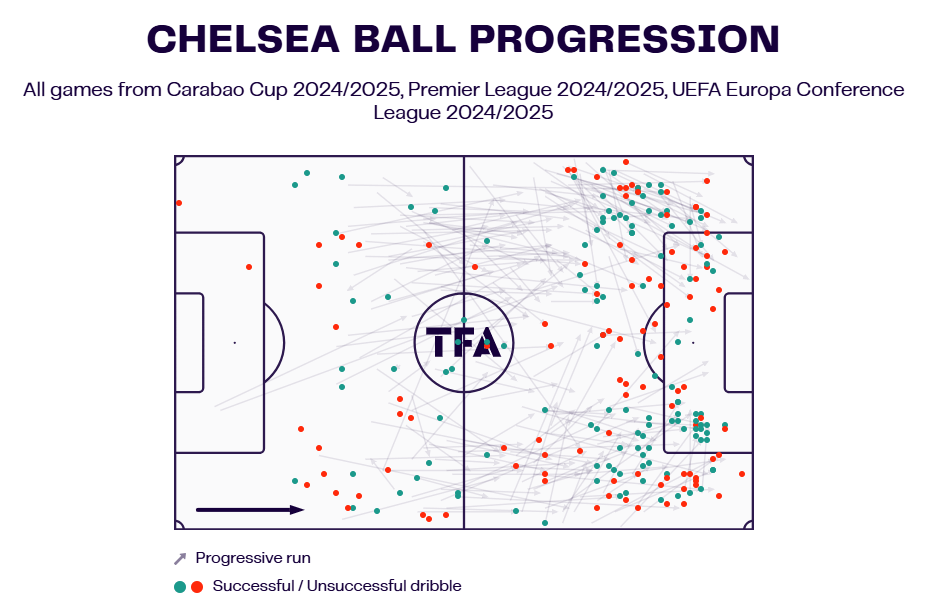
Chelsea FC Attacking Tactical Setups
Inverted Full-Backs
In the first image below, you can see Malo Gusto’s inverted role as he moves into the midfield, acting as a double pivot in the build-up.
This positioning allows Enzo Fernández the space and freedom to make daring forward runs, with Gusto covering defensively in case of a counterattack
Now that Enzo is able to push forward and drag an opposing Wolves midfielder out of position, Cole Palmer can comfortably take up the right-sided 8/10 role, moving into the space created.
This setup allows Chelsea to play around the opposition and shift play to their most influential player.
Palmer, as the central number 10, has been a critical asset in counterattacks.
He seamlessly drives forward and quickly combines to create chances, which has made him ideal for this position.
His role becomes even more pronounced when the ball is higher up the pitch.
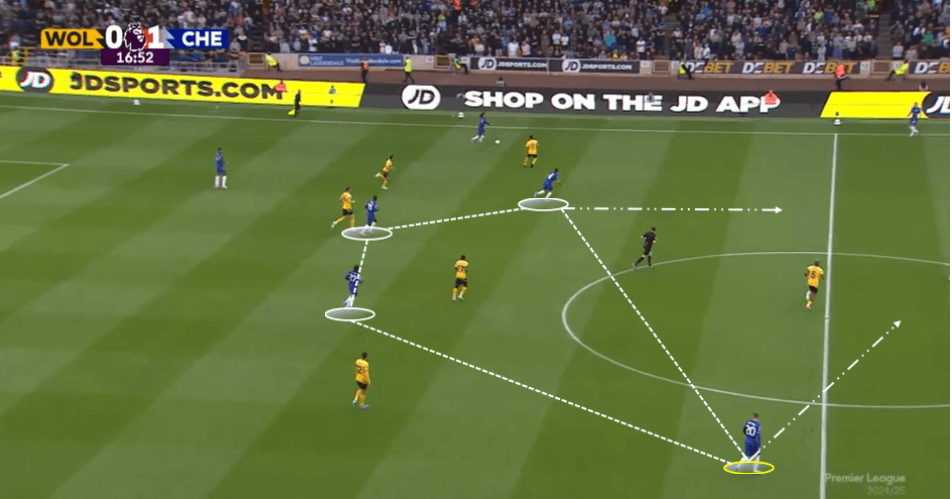
Chelsea’s Four-Attacker System
Chelsea often deploys a system where four attackers form a horizontal line, with the number 10 given the freedom to push high, almost creating a double-striker formation with two wingers.
This arrangement frequently causes an opposing centre-back to step up and challenge Cole Palmer as he drives into space, thereby opening up room for Nicolás Jackson to make runs in behind.
Watching Jackson’s gameplay footage, you’ll often notice him making vertical, straight-line runs where he thrives best.
This allows Palmer to serve as a creator, feeding either the inverted wingers or Jackson as he runs into open space now that the centre-back has been pulled out of position.
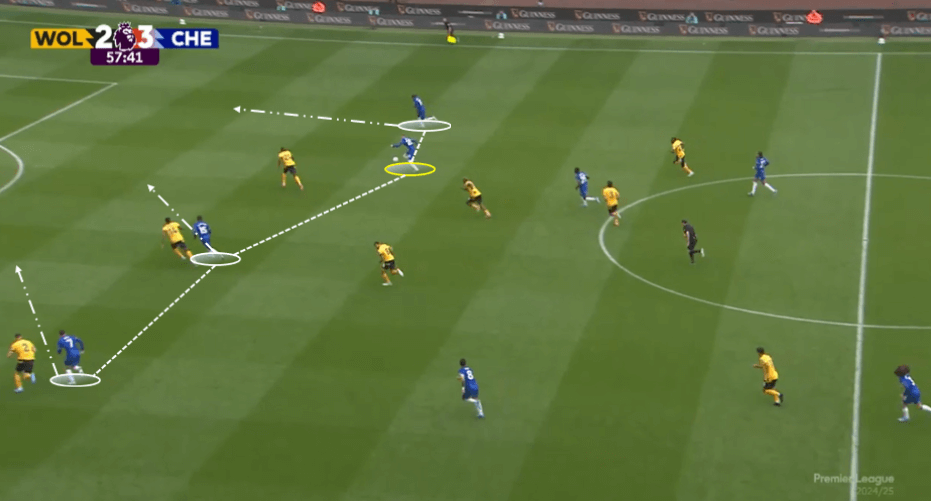
Wide & Inverted Winger Movements
Chelsea’s wingers maintain extreme width but look to move into inverted positions depending on where the ball is positioned.
When the ball is played centrally by Palmer or Enzo, the wingers stay wide along the touchline.
However, when the ball is in wide areas, they make inverted runs, drawing defenders away from Jackson, who then has clear passing lanes in front of him.
In this image, the four-man attack formation, which resembles two strikers and two wingers, is once again visible.
Jackson makes a run behind while the winger moves inward, creating chaos in the defence and space for Jackson to exploit.
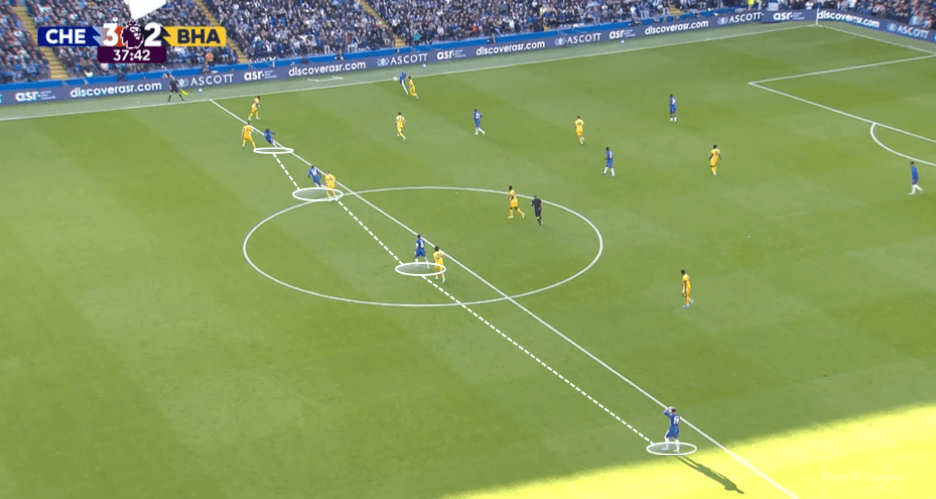
Example From Liverpool Match
In the match against Liverpool, Chelsea’s tactical setup directly led to their first goal.
When the ball was central, the wingers positioned themselves extremely wide, with their bodies angled inward as they prepared to run into the middle.
Jackson, meanwhile, made a run into space while the wingers drew the Liverpool full-backs away from their zonal marking positions.
This allowed Jackson to make a simple run behind the defence, creating a one-on-one chance with the goalkeeper that he successfully finished.
Palmer took up the right-sided number 10 role again, and you can see Enzo gravitating towards Palmer’s side of the pitch to support him as Chelsea’s primary playmaker.
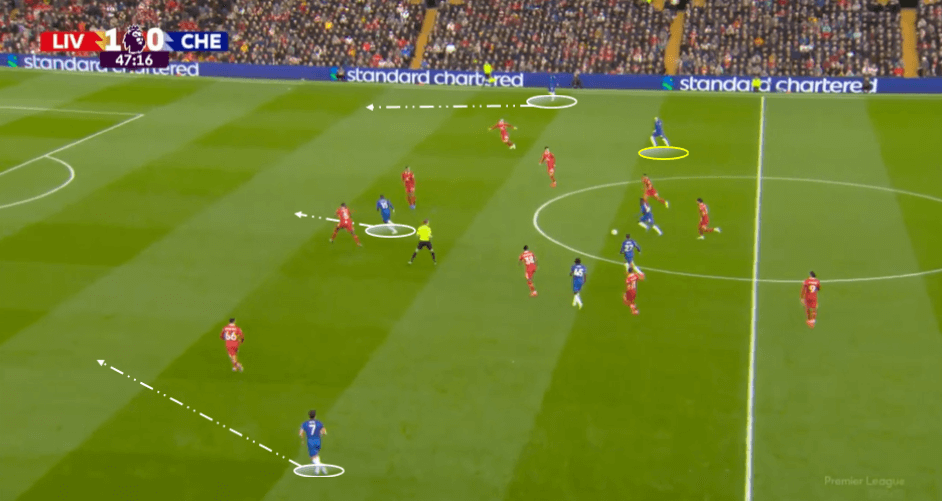
Example From West Ham Match
Another perfect example of this setup occurred against West Ham United.
Here, Palmer occupied the right-sided 10 role but did not push into the striker’s space.
His presence drew the attention of two opposing players, while the ball remained in a central zone with the Chelsea centre-backs
The wingers maintained their width, creating space for Jackson to continue making runs in behind, leading to multiple one-on-one chances with the keeper.
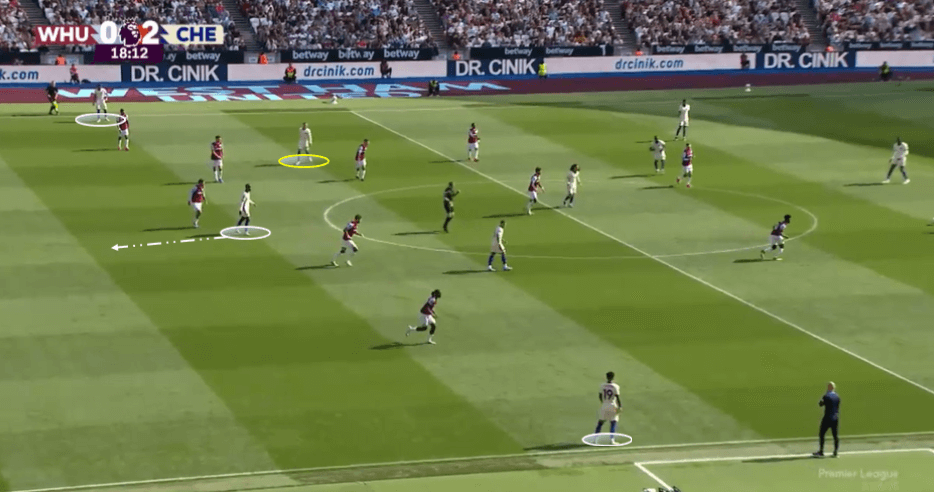
Conclusion
So far, Enzo Maresca’s coaching style at Chelsea has been a success.
Despite the lack of chemistry beforehand, he’s winning matches with the squad he’s been given and is adapting his dream tactics to suit the team.
His system incorporates all players into their attacking output, which is a challenge given the sheer number of attackers; however, he’s managing this perfectly.
Chelsea has players who can fill multiple roles, both in wide positions and the number 10 spots.
Cole Palmer and Nicolás Jackson play key roles in creating attacking opportunities and opening space during transitions to goal.
Maresca’s philosophy of controlled, possession-based play and structured offensive setups has provided Chelsea with a renewed attacking identity, allowing the team to maximise the vast potential of its young players.
This project could lead to domination in football once the squad has a few more years together.
With Chelsea now performing beyond expectations in both the Premier League and European competitions, there’s a clear sign that this tactical evolution, driven by Maresca’s philosophy, may finally restore Chelsea’s attacking threat on both domestic and continental stages.





Comments